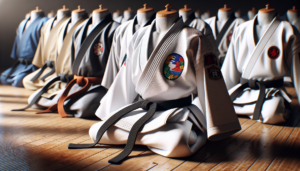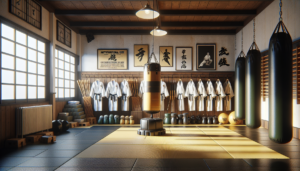Learning karate at home has become increasingly popular in recent years, thanks to the availability of online resources and dedicated applications. With the right approach and guidance, anyone can start their karate journey from the comfort of their own home. This comprehensive guide will walk you through the essential steps to begin learning karate at home, including the benefits, basic techniques, training plans, and staying motivated.
Introduction to Learning Karate at Home
Why Learn Karate at Home?
Learning karate at home offers several advantages. First, it allows for a flexible schedule, enabling you to train whenever it suits you best. Second, it eliminates the need to commute to a dojo, saving time and money. Finally, training at home provides a comfortable and familiar environment, which can be especially beneficial for beginners who might feel self-conscious in a group setting.
Benefits of Karate Training
Karate training offers numerous benefits for both the body and mind. Regular practice can:
- Improve overall fitness, including strength, endurance, and flexibility
- Enhance self-defense skills, boosting confidence and situational awareness
- Teach valuable lessons in discipline, focus, and perseverance
- Reduce stress and promote mental well-being
Getting Started with Karate at Home
Essential Equipment for Home Karate Training
To begin your karate training at home, you’ll need some basic equipment:
- Comfortable, loose-fitting clothing that allows for easy movement
- A karate gi (uniform), if desired
- A clear, open space for practice, such as a living room or backyard
- Optional: training aids like a punching bag or makiwara board
Setting Up Your Training Space
When setting up your training space, ensure that you have enough room to move freely without hitting any obstacles. If practicing indoors, remove any fragile objects or furniture that could be accidentally knocked over. For outdoor training, choose a level surface with good traction, such as grass or a mat.
Finding Online Resources and Classes
The internet is a treasure trove of resources for learning karate at home. Popular options include:
- YouTube channels like World Wide Karate Guide and Goju Ryu Karate Centre
- Online karate schools and courses, such as Dojo Go
- Mobile apps like “Karate Workout At Home”
Look for beginner-friendly lessons that cover the fundamentals and provide clear, step-by-step instructions. Many resources offer both short (10-20 minute) and longer (45-60 minute) sessions to accommodate different schedules and attention spans.
Basic Karate Techniques for Beginners
Stances and Footwork
Proper stances and footwork form the foundation of karate techniques. Some basic stances to learn include:
- Zenkutsu dachi (front stance)
- Kokutsu dachi (back stance)
- Kiba dachi (horse stance)
Practice transitioning between stances and moving in different directions to develop balance and agility.
Punches (Zuki)
Karate employs various punches, known as zuki, that target different areas of the body. Essential punches for beginners include:
- Choku-zuki (straight punch)
- Oi-zuki (lunge punch)
- Gyaku-zuki (reverse punch)
Focus on proper form, keeping your wrist straight and turning your hips for maximum power.
Blocks (Uke)
Blocks, or uke, are defensive techniques used to deflect incoming strikes. Fundamental blocks include:
- Age-uke (rising block)
- Soto-uke (outside block)
- Gedan-barai (downward sweep block)
Practice each block slowly at first, concentrating on proper alignment and timing.
Kicks (Geri)
Kicks, known as geri, are powerful techniques that extend your reach and can be used for both offense and defense. Basic kicks to learn include:
- Mae-geri (front kick)
- Yoko-geri (side kick)
- Mawashi-geri (roundhouse kick)
Remember to chamber your knee before extending your leg, and always maintain balance.
Developing a Karate Training Plan
Creating a Weekly Training Schedule
Consistency is key when learning karate at home. Create a realistic training schedule that fits your lifestyle and commitments. Aim for at least two to three sessions per week, with each session lasting 30-60 minutes. Allocate time for warm-up, technique practice, kata (forms), and cool-down.
Tracking Your Progress
Regularly assess your progress to stay motivated and identify areas for improvement. Keep a training log to record:
- Dates and durations of your training sessions
- Techniques learned and practiced
- Personal milestones and achievements
Celebrate your successes and learn from your challenges to maintain a positive attitude.
Enhancing Your Karate Skills
Improving Flexibility and Strength
Incorporate flexibility exercises and strength training into your routine to enhance your karate performance. Stretching before and after each session can help prevent injuries and improve your range of motion. Basic bodyweight exercises like push-ups, squats, and lunges can build the strength needed for powerful techniques.
Practicing Kata
Kata, or pre-arranged forms, are an essential part of karate training. They help develop proper form, balance, and mental focus. Begin with basic kata like Taikyoku Shodan or Heian Shodan, and practice them regularly. Pay attention to your stances, transitions, and breathing as you move through each sequence.
Engaging in Sparring and Self-Defense Drills
While sparring with a partner may be limited when training at home, you can still practice self-defense drills and shadow sparring. Visualize an opponent and respond with appropriate blocks, strikes, and footwork. Use a mirror to check your form and identify any openings in your defense.
Staying Motivated and Safe
Maintaining Discipline and Focus
Learning karate at home requires self-discipline and focus. Set clear goals for each session and strive to maintain a regular training schedule. If you find yourself losing motivation, revisit your reasons for learning karate and adjust your goals as needed. Remember that progress takes time and consistency.
Ensuring Safety During Training
To prevent injuries during home training:
- Always warm up properly before practicing techniques
- Use appropriate safety gear, such as padded mats or gloves
- Practice control and precision, avoiding reckless or aggressive movements
- Listen to your body and stop if you feel pain or discomfort
If you have any pre-existing medical conditions, consult with your doctor before starting a karate training program.
Conclusion
Recap of Key Points
Learning karate at home is a rewarding and accessible way to start your martial arts journey. By setting up a dedicated training space, finding reputable online resources, and practicing basic techniques consistently, you can develop a solid foundation in karate. Remember to create a balanced training plan, track your progress, and prioritize safety to ensure a positive learning experience.
Next Steps in Your Karate Journey
As you progress in your home karate training, consider:
- Joining an online karate community for support and guidance
- Attending virtual seminars or workshops to learn from experienced instructors
- Exploring different karate styles and their unique techniques
- Setting long-term goals, such as earning belt promotions or competing in tournaments
With dedication and perseverance, learning karate at home can be a fulfilling and transformative experience. Embrace the challenges, celebrate your achievements, and enjoy the lifelong benefits of this fascinating martial art.






